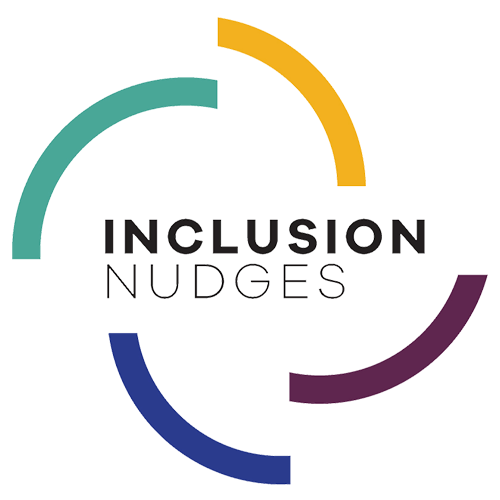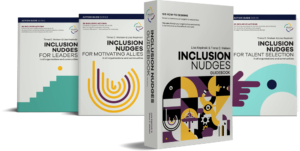Under pressure to speedily process information, our cognitive system can steer our thinking off course from our intentions of open mindedness, respect, and inclusion. With the vast majority of our thinking (system 1) operating on auto-pilot, faulty judgements can result based on feelings, snap observations, previous situations, stereotypes, societal norms, and beliefs from our upbringing. Reframing by changing what we see and say is a way to reshape our mental shortcuts to be more accurate and aligned with how we wish to be with ourselves and other people.
Normative patterns shape our perceptions
Throughout our lives we are constantly and unwittingly internalising messages about ourselves. These reflect the normative pattern of who is seemingly ‘good’, ‘attractive’, ‘smart’, ‘trustworthy’, ‘a leader’, ‘friendly’, ‘caring’, ‘strong’, ‘talented’, and so much more. These snap mental associations are powerfully reinforced through family, friends, influencers, media, education, rewards, organisations, and society. Constantly subjected to these perceptions, they shape our views and interactions with people and the systems we create and use. This can have a huge discriminatory impact on society and result in exclusion of many people who don’t fit the normative, dominate pattern. Changing this motivates us (and no doubt you, too) to do the work that we do for diversity, equity, and inclusion.
But what about on the personal level? We equally can hold negative associations about ourselves as our normative pattern. Additionally, for many people with nearly two years of video-based online work, there’s an emergence of what’s been called “Zoom dysmorphia” where we become negatively fixated on how we look. We do these types of judgments unconsciously against our own rationally-held positive self-beliefs. We (Tinna and Lisa) have both felt like outliers who don’t fit the norms throughout our lives for different reasons at various points. Perhaps you have as well?
It’s personal…
As behavioural change designers, we often practice on ourselves to help interrupt and reshape internalised negative messages, biases, and exclusionary behaviours.
Here’s a design that we created and we’ve been experimenting with to reframe our own perceptions about ourselves. We’ve named this:
“That’s a human…”
Here’s how we’ve done this.
Lisa’s story
I used the past 1 ½ years of lockdown to experiment with countering negative thoughts about my appearance. When looking in a mirror, I often would only take quick glances at parts of me (was my hair brushed, teeth clean, clothes neat, …?). When I would look for just a second ‘too long’, in would creep negative headlines and my own internal argument with this. What a waste of energy between the critical and the confident parts of me! I wanted to redirect that energy to re-setting what I heard and said when I looked in the mirror. And having a lot of time to myself during lockdown, … well, what a perfect time to try out something.
I was inspired by the Inclusion Nudge example called Re-Frame ‘Migrant’ to ‘Human’ in The Inclusion Nudges Guidebook. In this design, members of the South African non-profit organisation PASSOP actively comment on social media postings that used the words ‘refugee’ or ‘migrant’ with the word ‘human’ to re-focus on people. So, for example, when a posting mentioned a ‘refugee crisis’, they would write a comment that it’s a ‘human crisis’. The words used help to reframe perspectives towards the desired outcomes — to see and treat people as humans. To shift perceptions, we need to often start with what we say.
With this design in mind, I started out to play with my design. Here are some steps that I did.
- I gave my experiment a title — “Finding Your Face”. This title frame helped to remind me that it’s my face and I own what I see and think about it.
- I shared with a few people about what I was doing—this is a commitment nudge to increase my likeliness to do it. My mother and daughter often asked, “How is your project Finding Your Face going?” and often I would send them selfies. They brought in a supporting accountability framework that I kept it up.
- I also posted a note on my bathroom mirror which said, “This is a human face”. Every time I looked in that mirror, I would say it aloud. Eventually, I moved to also saying, “This is a human body”. And nothing more. No critical comments of “…yes, but …”. If any other critical messages started creeping in, I would say it again, “This is a human face”. The note on the mirror is the nudge design to prompt me to keep at it, to reduce the effort by providing the statement, and it was in the right place, at the right time.
Quickly, these statements have become a fairly regular habit and I have extended it for when I see other people, which actually felt like less of an effort (we are most critical of ourselves, aren’t we?). I’ll catch myself thinking “That’s a human face” or “That’s a human body” when I see others. And when I hear that statement in my mind, I check in with what did I think just before about the person. Because we so quickly make mental associations, I can’t always pull this up to my conscious thinking. But in many cases, I am able to recall, and it shocks me. This dissonance of inclusive intentions against my actual thoughts and unconscious-resulting actions helps to motive me to keep on practicing this reframing technique on myself and with others. We know that bias will never be ‘cured’ or ‘go away’, but we can put in designs to help interrupt, allow space for better thinking, and literally change what we see.
Tinna’s story
I was so inspired when Lisa told me about this ‘That’s a human…’ experiment. I started saying this to myself “There’s a human being” when I would see people in the public space because I noticed how often my mind would pay attention to the appearance of other people, often with a judgemental attitude, such as “she is skinny” or “she is tall” or “he is overweight” or “ugly shoes”. I really did not like this tendency and I was ashamed of this. But I also had a difficult time changing this. With this default statement of “there is a human being”, I started noticing more positive energy within and I didn’t get to the judgemental state because just as quickly as the moment arose, just as quickly it disappeared. I also noticed that I felt less as an outlier myself being 185 cm tall. I am also just a human being among others.
We (Lisa & Tinna) hope our experiment inspires you to try this out. Here’s some background on how re-framing can be a powerful approach.
Framing Perceptions Inclusion Nudges
Judgments of body shape, appearance, and voice can dominate how we think of ourselves, despite having a strong sense of self, accomplishment, and value. This is an absurd reality that’s happening within our own minds! Surely, we should be able to control this! Why would we negate ourself? Well, that’s the challenge with how to lessen the influence of bias—we can’t just wish it away. It still creeps in. This is why we need to leverage behavioural insights to design ways to re-shape our harmful mental messages. Framing Perceptions Inclusion Nudges are an effective way to do this.
“Framing Perceptions Inclusion Nudges are designs that alter perceptions to help the brain perceive issues related to inclusion, diversity, equality in a resource discourse. The designs also prime specific associations and counter stereotypes. Altering the framing of an issue or message and changing the anchor of a thought process helps to promote inclusive behaviour because it influences the reactions in the automatic, stereotyped, and unconscious mind.”
The Inclusion Nudges Guidebook, Kepinski & Nielsen
We both constantly use the Framing Perceptions designs in our lives and work. One of these is the Inclusion Nudge design called Ask Flip Questions to Change Your Perceptions in the Moment which is described in The Inclusion Nudges Guidebook and in all three of the Inclusion Nudges Action Guide books. So many people have told us that this Framing Perceptions design has been hugely impactful for them in expanding thinking, information gathering, and decision making in their daily work and lives. Maybe you want to give this one a go as well?
To learn more about Framing Perceptions designs, here are more resources to inspire you. We are curious to hear from you on how you’ve used re-framing to lessen the influence of negative biases and stereotypes in your life. Drop us an email at contact@inclusion-nudges.org
These Framing Perceptions Inclusion Nudges can support reframing for inclusivity:
Re-Frame ‘Migrant’ to ‘Human’ in The Inclusion Nudges Guidebook
Images Framing Immigrants as One of Us in The Inclusion Nudges Guidebook and in Inclusion Nudges for Motivating Allies
Interrupt Gender Caregiver Stereotypes with Images in The Inclusion Nudges Guidebook and in Inclusion Nudges for Motivating Allies
Want to read more about re-framing designs? See these other blog articles:
Reframe Language on How We Work Today
Diversity Is About People, Not Flowers, Candy, or Pencils
Don’t Set Targets for Women – But for Max 70% of the Same Gender







